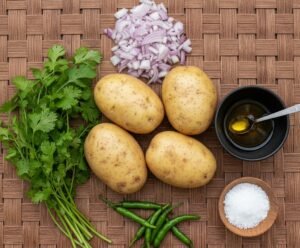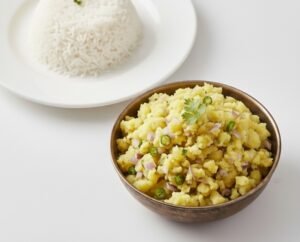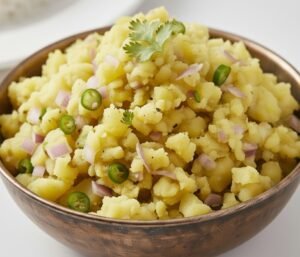Assamese cuisine is all about simplicity, freshness, and deep-rooted tradition. Among the many heartwarming dishes from Assam, one name that stands out for its humble charm is Aloo Pitika. This mashed potato dish might seem simple at first glance, but once you taste it, you’ll realize it carries the warmth of Assamese kitchens and the authenticity of rural life. It’s not just food—it’s comfort in its purest form.
Aloo Pitika, often served as a side dish with rice and dal, represents the essence of Assamese comfort food—light, flavorful, and unpretentious. In every Assamese household, this dish is a daily favorite, loved by both children and adults alike. Whether it’s a quick weekday meal or part of a festive platter, Aloo Pitika always finds its place on the table.
What is Aloo Pitika?
In simple terms, Aloo Pitika is Assamese-style mashed potatoes. But calling it just “mashed potatoes” doesn’t do justice to its unique taste and identity. “Pitika” literally means “smashed” or “mashed” in Assamese, and Aloo Pitika is the potato version of this concept. Unlike Western mashed potatoes that are buttery and creamy, Aloo Pitika is flavored with mustard oil, green chilies, onions, and sometimes roasted ingredients that add a smoky twist.
This dish brings together earthiness from mustard oil and freshness from herbs like coriander and spring onions. It’s often eaten with steamed rice and dal, making it a wholesome, comforting meal. The best part? You don’t need fancy ingredients or complicated cooking techniques. Just a handful of simple items, and you’re ready to enjoy a dish that speaks volumes about Assam’s food culture.
History and Origin of Aloo Pitika
The roots of Aloo Pitika lie deep in the Assamese countryside. Historically, it was a quick side dish prepared in rural homes where fresh vegetables and locally grown produce were abundant. In times when elaborate cooking wasn’t feasible, Pitika became the go-to recipe. People would boil vegetables, mash them, and mix them with mustard oil and spices—creating a variety of Pitikas such as eggplant pitika (bengena pitika), fish pitika, and of course, the beloved Aloo Pitika.
Over generations, Aloo Pitika became a staple on Assamese dining tables. It wasn’t just food; it symbolized simplicity and togetherness. Even today, Aloo Pitika continues to remind people of their cultural roots and the soothing taste of home.
Why Aloo Pitika is So Popular in Assam
So, why is this humble dish so loved? The answer lies in its simplicity and versatility. Aloo Pitika can be made in minutes and pairs perfectly with almost any Assamese dish. Its mildly spicy, tangy, and smoky flavors balance out the richness of other foods on the plate.
It’s also incredibly flexible—every family has its own version. Some like it with raw onions for crunch, others prefer roasted garlic for depth. And when you drizzle that pungent mustard oil over warm mashed potatoes, it releases an aroma that’s pure nostalgia for anyone from Assam.
Moreover, it’s a dish that doesn’t discriminate—it’s for everyone, every day. From humble farmers to city folks, Aloo Pitika connects generations with a single bite.
Health Benefits of Aloo Pitika
One of the most appealing aspects of Aloo Pitika is that it’s as healthy as it is tasty. This dish uses boiled potatoes as its base—an excellent source of carbohydrates that provide energy and help keep you full for hours. Potatoes also contain essential nutrients like vitamin C, potassium, and fiber, which aid digestion and boost immunity.
Then comes mustard oil, a staple in Assamese kitchens. It’s not just added for its distinct sharpness but also for its numerous health benefits. Mustard oil is known to be rich in monounsaturated and polyunsaturated fats—healthy fats that promote heart health and reduce cholesterol levels. It also has antimicrobial properties and aids in improving blood circulation.
Adding ingredients like onions, green chilies, and coriander brings in antioxidants and vitamins that strengthen your body. Plus, because Aloo Pitika is usually prepared with minimal oil and no heavy spices, it’s light on the stomach. Whether you’re recovering from illness or just craving comfort food, this dish fits perfectly into any diet.
Another hidden health benefit lies in its simplicity—it’s made from whole, natural ingredients with zero preservatives. In a world where fast food and processed snacks dominate, a bowl of Aloo Pitika feels like a wholesome return to traditional, mindful eating.

Ingredients Required for Assamese Aloo Pitika
Before you dive into making this dish, let’s gather everything you need. The beauty of Aloo Pitika lies in its simplicity—most of the ingredients are easily available in any kitchen.
Core Ingredients:
-
3 to 4 medium-sized potatoes
-
2 tablespoons mustard oil (adjust to taste)
-
1 medium onion (finely chopped)
-
2 to 3 green chilies (chopped)
-
Salt to taste
-
Fresh coriander leaves (finely chopped)
Optional Add-ons for Extra Flavor:
-
Roasted garlic (adds smoky depth)
-
A dash of lemon juice for tanginess
-
A pinch of roasted cumin powder
-
Boiled eggs (for egg pitika variation)
-
Fried dry fish flakes (for fish pitika variation)
The amount of mustard oil is particularly important—it gives Aloo Pitika its authentic Assamese aroma. Make sure to use raw mustard oil, not refined, because that’s where the real flavor comes from.
Choosing the Right Potatoes
Not all potatoes make good Aloo Pitika. The key is texture. You’ll want potatoes that are starchy yet not too mushy once boiled. Varieties like “Jyoti,” “Kufri Chandramukhi,” or other local Assamese potatoes are ideal for this dish because they mash smoothly without turning sticky.
If you’re outside Assam, Yukon Gold or Russet potatoes also work well. Always boil the potatoes just right—not undercooked, not overcooked. Once boiled, peel them while still warm; that’s when they mash best and absorb the flavors of mustard oil and spices perfectly.
To make your Pitika more flavorful, try boiling the potatoes with a pinch of salt. This helps season them from the inside. And if you prefer a slightly smoky twist, you can roast one or two boiled potatoes on an open flame for a few seconds before mashing. It adds a beautiful, earthy undertone that enhances the overall dish.
Step-by-Step Preparation of Aloo Pitika
Now that your ingredients are ready, let’s make some authentic Aloo Pitika the Assamese way.
Step 1: Boil the Potatoes
-
Wash and peel 3 to 4 medium-sized potatoes.
-
Boil them in salted water until they’re soft but not falling apart.
-
Drain and let them cool slightly before mashing.
Step 2: Mash the Potatoes
-
Place the boiled potatoes in a large bowl.
-
Mash them using your hands or a spoon until smooth but still a little coarse. (Traditional Assamese households prefer a hand-mashed texture—it feels more rustic and authentic.)
Step 3: Add the Flavors
-
Add chopped onions, green chilies, and coriander leaves to the mashed potatoes.
-
Pour in mustard oil—don’t skip this step! The oil’s pungency transforms the dish completely.
Step 4: Mix Well
-
Use your hands to combine everything thoroughly. The warmth from your hands helps release the aroma of mustard oil and binds the flavors beautifully.
-
Taste and adjust salt or chilies as needed.
Step 5: Serve Fresh
-
Aloo Pitika is best served fresh and slightly warm. Enjoy it with plain steamed rice, dal, and maybe a wedge of lemon on the side.
Pro Tip: For an authentic Assamese experience, serve Aloo Pitika on a banana leaf—it enhances both the presentation and the aroma.

Serving Suggestions
Traditionally, Aloo Pitika is served as a side dish in a full Assamese meal. The classic combination is Aloo Pitika with rice and dal, often accompanied by a wedge of lemon and a small serving of fried greens or pickles.
It’s also perfect with roasted fish or simple lentil soups, balancing the meal with its mild yet tangy flavor. For a comforting vegetarian lunch, you can pair it with masoor dal and steamed vegetables.
If you’re hosting a cultural Assamese dinner, Aloo Pitika can be served alongside other traditional items like “khar,” “tenga,” and “pitika” variations of different vegetables. It’s one of those dishes that quietly complements everything on the plate while holding its own charm.
And for those who enjoy fusion ideas—try using Aloo Pitika as a filling for sandwiches or wraps. The mustard oil flavor adds a unique twist to the otherwise plain mashed potato sandwich.
Variations of Aloo Pitika
One of the most wonderful things about Assamese cuisine is its creativity with simple ingredients. Aloo Pitika may be the most popular version, but “pitika” itself is a category of dishes that involves mashing different ingredients with mustard oil, onions, and chilies. Let’s explore a few delicious variations that you can try in your own kitchen.
-
Egg Pitika (Koni Pitika)
This version is made by boiling eggs and mashing them along with onions, green chilies, coriander, and a touch of mustard oil. The result is a protein-rich, flavorful dish that pairs beautifully with rice and dal. Sometimes, people mix both potatoes and eggs together to make a hybrid version—rich, creamy, and full of aroma. -
Fish Pitika (Maas Pitika)
A favorite among non-vegetarians, this variation uses roasted or fried fish, usually small river fish, mashed with onions, chilies, and mustard oil. It’s smoky, spicy, and perfectly Assamese in flavor. For an added layer of taste, some even roast the fish over an open flame before mashing it. -
Tomato Pitika (Bilahi Pitika)
This one’s a burst of tangy freshness. Roasted or boiled tomatoes are mashed with onions, chilies, and coriander, creating a sweet, sour, and spicy blend that complements rice perfectly. -
Bengena Pitika (Brinjal Pitika)
Made from roasted eggplant, this is another iconic Assamese dish. The roasted brinjal’s smoky texture and flavor make it irresistible when combined with mustard oil and green chilies. -
Kachu Pitika (Colocasia Pitika)
Colocasia roots are boiled and mashed just like potatoes, giving a stickier and richer texture. This version is especially common in rural Assamese households and has a unique earthy flavor.Each pitika variety carries the same essence—simplicity, freshness, and authenticity—while offering its own unique twist. Whether you stick with the classic Aloo Pitika or experiment with these variations, each one promises comfort in every bite.
Tips and Tricks for Perfect Aloo Pitika
While Aloo Pitika may seem simple to make, achieving that perfect balance of flavors takes a little bit of practice. Here are some expert tips to help you nail it every time:
-
Use the right mustard oil: Always go for cold-pressed mustard oil, as it retains its natural pungency. Lightly heating the oil before mixing can mellow down its sharpness if you find it too strong.
-
Mash while warm: The texture of your Pitika depends on mashing the potatoes while they’re still warm. It helps in even blending and brings out the natural creaminess.
-
Avoid over-boiling: Overcooked potatoes can make the mixture watery. Boil until just tender enough to mash.
-
Balance the spice: Assamese cuisine is known for being mild yet flavorful. Don’t overload with chilies; let the mustard oil be the star.
-
Add roasted ingredients: Roasted garlic or roasted dry chilies can add a beautiful smoky note to your Pitika.
-
Garnish smartly: A final sprinkle of chopped coriander or spring onions can instantly freshen up the dish.
-










